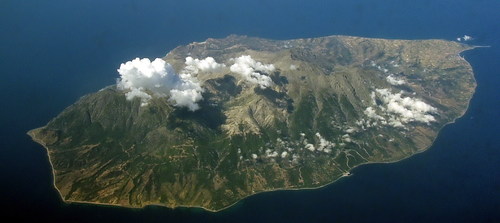Samothraki

Samothraki is an island of the Thracian sea. It is located in the northern-eastern part of the Aegean Sea among the islands of Limnos, Imvros and Thasos and is 24 nautical miles from Alexandroupolis. The surface of the island is 178 square kilometres, while its highest mountain top is 1664 m above sea level. With such a height, Samothraki is the highest Greek island- with the exception of the two large ones, Crete and Evoia. Samothraki’s mountain is called Saos, but the local people call it “Feggari” (a name shared with the mountain’s highest top), which means the moon, because as they say, “it is so high that covers the moon”. Besides, the island’s name means “high Thrace”- from the ancient Greek samos=high.
Samothraki, which is both a province and municipality, administratively belongs to the prefecture of Evros- its only island. According to municipal evidence the residential population is 3.083 inhabitants. Through the port of Kamariotissa, Samothraki is connected by coastal shipping with Alexandroupolis, Kavala, Laurio and other Aegean islands. The economy of Samothraki is mainly based on tourism and fishery.
Samothraki is known worldwide because of the famous ancient statue of Niki, which was found in 1863 on the island. The statue, 2.75m high, is exhibited in the Louvre museum in Paris. In ancient times the Kaviria Mysteries, which were occult ceremonies and until today their content has not come to light, took place on the island.
Natural features
Samothraki constitutes a place with unique natural beauties. This uniqueness is because of the wild unspoilt nature with the steep mountains, the rich fauna and flora, the forests of plane trees - covering all the slopes and reaching the sea- pine, chestnut, cedar and other trees. Also, there are running waters, falls, small lakes - called Vathres – along the mountain slopes and very beautiful coasts. The island has an oval shape with a 59 kilometers coastline, of which approximately the 35 kilometers are beaches and most of them are rocky. The sea area around Samothraki is one of the richest in the whole Mediterranean Sea, because of its marine life.
Tourism
Even though Samothraki has all these unique beauties and archeological interest coming from all historical eras, tourism is not so developed as in other Greek islands. But this fact may be the main reason that the island remains unspoilt with a preserved natural environment without the ruthless exploitation that characterizes other regions in Greece, especially the islands.
History
Samothraki did not have a particularly political importance in ancient times because it did not have a natural port. However, there was a large religious interest because of the Kaviria Mysteries. Those mysteries took place in the “Sanctum of the Great Gods”, which is now the most important archeological site. It is said that during the Kaviria Mysteries the parents of Alexander the Great, Phillipos II and Olympiada, met for the very first time and on the island they conceived the Great General. During these Mysteries both free citizens and slaves could take part, in contrast with the Eleusinian Mysteries in which the slaves could not participate.
Samothraki was inhabited first by the Pelasgians and later by the Thracians. The ancient city, Palaiopoli, is located in the north of the island, where its impressive ancient walls built in the cyclopean style still remain. At the end of the 8th century BC the island was inhabited by the Greeks of Samos. In 508 BC it was occupied by the Persians, but later it came under the control of Athens, after which and until 168 BC Samothraki was under the Macedonian domination. After the Battle of Pidnas, Samothraki gained its independence, but in 70 AC, the emperor Vespasianos integrated the island in the Roman Empire.
The next dominance was by the Byzantines until 1204, afterwards by the Venetians and in 1355 by the Gatilouzi family from Genoa. The Genoa fortress still remains along with the “Gatilouzi Tower”, another very important monument.
The Ottoman Empire conquered Samothraki in 1457 and when the locals rebelled against them, the Turks killed the majority of the Greek population. Finally, Samothraki was liberated after the Balkan Wars in 1913, though during the 2nd World War it was occupied for a short period by the Bulgarians.




